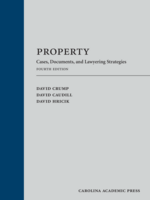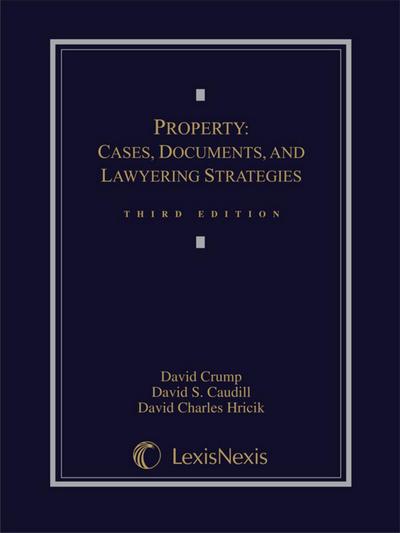This book has been replaced by a newer edition:
Property: Cases, Documents, and Lawyering Strategies, Fourth Edition
by David Crump, David Caudill, David Charles Hricik
2020, 932 pp, casebound, ISBN 978-1-5310-1887-0
$215.00
Teacher's Manual available
Property
Cases, Documents, and Lawyering Strategies
Third Edition
by David Crump, David Caudill, David Charles Hricik
2014
Tags: Property/Community Property
Teacher's Manual available
1136 pp $202.00
ISBN 978-0-76985-281-2
Looseleaf 978-0-76985-301-7
eISBN 978-0-32717-664-0
This Property casebook makes the topic of Property Law come to life by emphasizing aspects of property transactions that are important today. At the same time, its organization and coverage reflects customary course coverage. On the one hand, the broad subjects covered in this book are traditional. Personal property, real estate transactions, servitudes, leases, common law estates, and land regulation—the subjects that long have formed the backbone of the Property course - are all present. On the other hand, this is a course for the Twenty-First Century. Personal property is treated through coverage of intellectual property: patents, copyrights, trademarks, and trade secrets. Property transactions are approached from the point of view of a contemporary lawyer representing a client. The book covers current documents, contemporary doctrines, and relevant concepts.
Property: Cases, Documents, and Lawyering Strategies is MacCrate-responsive. It develops the strategy component. Each of the transactional chapters features problems that put the student into lawyering situations. After all, lawyering is not about reading appellate court opinions and discussing in a vacuum whether the opinions are "good" or "bad." Instead, it is about resolving or avoiding problems. To achieve those ends, lawyers use strategies for counseling, negotiation, document preparation, and litigation. The problems are set in a variety of different property settings and call for a variety of strategies.
This book is also designed to fit with other courses traditionally taught in the first year. Therefore, analysis of statutes and reading of appellate opinions and other traditional materials make up the bulk of the book. Still, the strategies and competencies of property lawyering are developed here, so that students can learn about them.
This book also develops the public law aspects in the law of property. But most of the efforts of lawyers in property transactions focus upon negotiation and documentation of private agreements. The documents are as important as public law. Therefore, property transfer agreements, brokerage documents, deeds, mortgages, title insurance policies, promissory notes, and other documents all are set out and explored in this book.
This book also is available in a three-hole punched, alternative loose-leaf version printed on 8.5 x 11 inch paper with wider margins and with the same pagination as the hardbound book.



